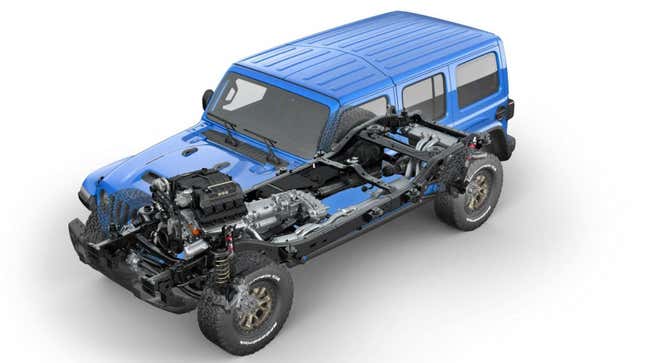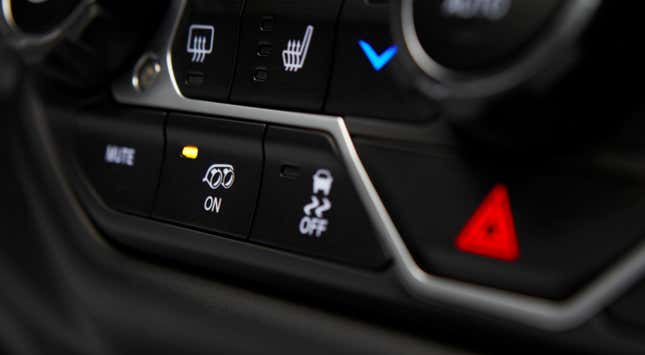
For the first time ever, the four-door Jeep Wrangler is actually quick. Ever since the Wrangler became a family-hauler for the 2007 model year, the two-ton beast has been saddled with engines making horsepower in the 200s. But now the big Jeep cranks the dial up to 470 courtesy of the 6.4-liter V8 found in the Dodge Charger and Challenger. Just look at this monster.
The four-door Jeep Wrangler has deserved a V8 ever since it debuted over a dozen years ago. Instead, the off-roader had to make do with a weak 3.8-liter “minivan motor” before finally upgrading to an acceptable naturally aspirated Pentastar V6 for the 2012 model year. When the JL-generation launched, it got an upgraded version of that V6 and a decent 2.0-liter turbocharged inline-four. Only recently did Jeep put a truly worthy engine into the Wrangler — a 3.0-liter turbodiesel — but that motor is all about torque. Now the Wrangler has an engine with actual power — enough to accelerate the SUV from zero to 60 mph in a claimed 4.5 seconds.
It’s a 392 cubic-inch V8, or — for those of you not accustomed to ‘murican units — divide 392 by 61 and you arrive at 6.4-liters. All of that displacement acts to spin the input shaft of the same 8HP75 automatic standard on the diesel Wrangler. Hooked to that transmission is a Selec-Trac full-time four-wheel-drive system with auto, high, neutral and low modes.

Two driveshafts send power from that transfer case to two wide track Dana 44 solid axles. Jeep calls these axles “heavy-duty” and writes in its press release (which I’m pulling from JL Wrangler Forums, since Jeep itself won’t officially reveal the car until Tuesday at noon Eastern time) that the tubes are thicker than Dana 44s standard on other Wranglers.
The axles feature electronic locking differentials with 3.73 gears and have 33-inch BF Goodrich KO2 all-terrains bolted to their hubs. Falken mud-terrains are optional. (With the lift, the tires look a bit small in my eyes. The first thing I’d do on buying one of these at a yet-to-be-named price is throw on some 35s).

The live axles are suspended below a frame whose rails Jeep calls “upgraded.” Coil springs and Fox shocks fill the span between the axles and frame, offering a two-inch lift compared to a standard four-door Wrangler (or one-inch lift compared to the Rubicon, Car and Driver notes). “Front upper control arms and cast-iron steering knuckles to take full advantage of the Wrangler Rubicon 392’s power and torque,” Jeep writes in its press release, going on to say, “Heavy-duty brakes bring the Wrangler Rubicon 392 to a composed stop no matter the terrain.”
Suspecting that some of the hardware might be shared with the Wrangler-derived Jeep Gladiator pickup or its desert-running variant, the Jeep Gladiator Mojave, I reached out to FCA. A company rep broke down the commonalities in the suspension, writing in an email:
The Wrangler Rubicon 392 front axle is a modified version of the Gladiator Mojave axle, with the thicker tubes and cast iron knuckles, and 3.73 final drive ratio. It uses the Rubicon front locker. The rear axle has thicker axle tubes and modified suspension hard points for improved handling, a 3.73 final drive ratio and a locker. But it is not a Gladiator Mojave rear axle.

The 2021 Jeep Wrangler 392's hood features a giant scoop, which is there not just for looks but also to feed the engine’s intake. The oval hole shown in the picture below matches up with the intake seal shown in the engine bay photo a few photos up.
The hood, Jeep notes, includes a tortuous air intake path with strategically placed drains that prevent water intrusion into the engine’s intake manifold, allowing the Jeep to ford pools up to 32.5 inches deep; it stands to reason that the system allows the V8 machine to blast through shallower water at higher speeds than one could attempt with a standard Wrangler.
Jeep has trademarked its air intake system, using the name Hydro-Guide. Here’s Jeep’s description of the setup, which apparently includes a secondary intake in the hood should the scoop be completely blocked off by water or mud. The clip above also shows the drains in the system:
Jeep engineers ensured the Wrangler Rubicon 392’s V-8 gets fresh air, regardless of the terrain and weather. The Wrangler Rubicon 392’s Hydro-Guide™ air intake system includes a tri-level ducting system with a series of drains, including a one-way drain in the air box that separates water – up to 15 gallons per minute – away from the engine’s incoming air. This enables the Wrangler Rubicon 392 to traverse water up to 32.5 inches deep worry free, even if a bow wake washes over the hood.
Should the Wrangler Rubicon 392’s functional hood scoop become restricted by snow, mud or debris, a secondary air path within the hood structure feeds the engine, making it possible for the Wrangler Rubicon 392 to reach top speed even with a fully blocked primary air path.

The beefed-up hardware, lift kit and unique air intake aren’t the only performance upgrades for the Wrangler 392. Off-road geometry is also improved thanks to the lift, though the difference over a standard Wrangler Rubicon isn’t dramatic.
The Wrangler 392's approach angle is 44.5 degrees, the departure angle is 37.5 degrees, breakover angle is 22.6 degrees and overall ground clearance sits at 10.3-inches. The regular four-door Rubicon’s approach and departure angles are half a degree lower, the breakover angle is the same, and ground clearance is actually half an inch more than the 392's. Given that the 392 has an inch lift and sports the same tires as the Rubicon, this might seem a bit odd, but per an FCA representative, the 392's exhaust system and the skid plate to protect it are what reduce overall clearance.

Other changes for the V8 Wrangler over its sub-300 HP siblings include an Off-road Plus mode, which lets the rear axle lock at high speeds in four-wheel drive high range. It’s unclear how this system works; other Wrangler trims require the vehicle to be stationary to lock the axle.
Styling touches over the Wrangler Rubicon include bronze badging on the leather interior and bronze exterior emblems as well as bronze-painted tow hooks and larger grille openings (done primarily for additional cooling). Also, half-doors finally make their debut for the JL-generation Wrangler.
Having now mentioned the interior, it’s worth noting a button in the center stack that shows a depiction of two exhaust tips. The button’s function is to toggle the quad exhaust between two modes, one quiet and one loud, the latter of which bypasses the muffler.

You can get an idea of what the loud mode sounds like in this short teaser that Jeep posted to its Facebook page. It sounds like a Dodge Challenger/Charger, and that’s a damn good thing:
In a world currently suffering from Broncomania, Jeep is looking to gain back some attention; throwing a powerful V8 into an off-road legend like the Wrangler seems like a great way to do it, especially given that the new Bronco doesn’t offer a V8, and its most powerful engine is a turbo V6 making just 310 HP.
Jeep Wrangler demographics have changed markedly since the TJ two-door bowed out after the 2006 model year, with the Wrangler nameplate no longer denoting a machine used primarily as a recreational off-roader for those willing to deal with major space compromises. Instead, the Wrangler is a daily-drivable off-roader piloted by many folks who perhaps previously drove full-size trucks or even performance cars. And you know what full-size trucks and performance cars have in common? Big engines. V8 engines. So it’s about damn time Jeep offered one.